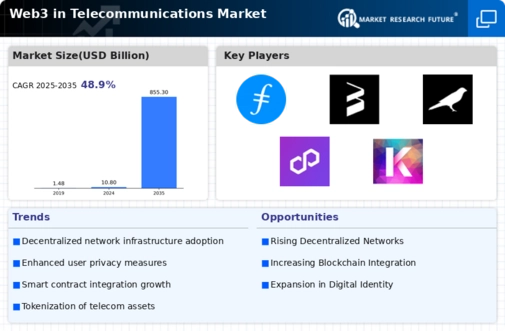Market Trends
Key Emerging Trends in the Web3 in Telecommunications Market
Web3 Technologies are reshaping the E-Commerce and Retail industry; thus, companies are adopting different approaches to position themselves properly and capture market share. One important strategy includes leveraging the transparency built into blockchain technology for trustworthiness purposes. Decentralized positioning plays a role in determining market shares within Web3's core tenet of decentralization. Using decentralized models in electronic commerce platforms allows users to have control over their data or transactions that they carry out within them as intermediaries' role reduces significantly; this move is favorable because customers prefer self-determination as they see themselves become user-centric businesses reacting to individual needs. Besides, reduced intermediaries mean lower costs through decentralized systems, culminating in direct cheap transactions and thus making firms gain competitiveness. Smart contracts that characterize Web3 also aid firms in securing market positions via automation tools, thereby enhancing efficiency levels. For example, online merchants who adopt smart contracts can use them to simplify payment processing systems, among other activities such as order fulfillment processes, as well as supply chain management aspects like paying suppliers or receiving goods from them on time after confirmation of an order. Tokenization is a disruptive strategy within the Web3 framework, enabling businesses to issue tokens on blockchain networks. These tokens have multiple functions, such as loyalty points or even incentives for user actions like sharing and transferring their rewards across various platforms, among other activities. By adopting tokenization measures, E-Commerce and Retail enterprises can boost customer retention rates. Such an approach presents organizations as forward-thinking establishments that constantly interact with the customers and reward them when the need arises for marketing purposes. Interoperability is one of the factors that distinguishes it from other systems on Web3, where things can be seamlessly integrated into different places and ecosystems. For instance, e-commerce firms using interoperable solutions attract larger numbers of users, hence expanding their market coverage. In this case, these strategies are mutually beneficial to some extent because they create synergies with other Web3 projects, thus promoting collaboration among various participants. To illustrate this point further, augmented reality (A.R.) and virtual reality (V.R.) technologies provide additional ways through which market shares can be determined in the Web3-driven E-Commerce and Retail industry space. AR/VR integration allows companies to give out shopping experiences that are quite immersive; hence, they stand out to front-line consumers who fancy gadgets. It also delves into more than just ordinary online buying, giving consumers unique involvement with products before deciding whether to purchase them or not. Customers see firms that integrate these immersive technologies as innovative entities that understand how their demands keep changing.








Leave a Comment